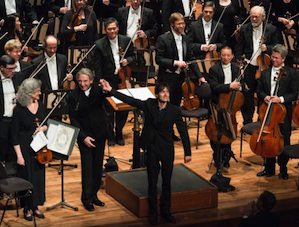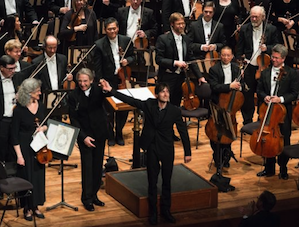
Photo by Kristen Loken
The concert series that Michael Tilson Thomas and the San Francisco Symphony are currently presenting carries several different labels: “Re/current,” “Project San Francisco,” and just “Beethoven & Bates Festival.” But whatever the correct nomenclature is, it’s part of a multiseason exploration of the music of both Ludwig van Beethoven (1770–1827) and Mason Bates (b. 1977).
The S.F. Symphony and Bates have a long-standing relationship, which resulted in the commissioning and premiering of several pieces. One of them is called The B-Sides from 2009, which is dedicated to MTT and was performed again during the first concerts of this season’s “Beethoven & Bates Festival.” I attended the Friday evening performance.
The concert opened with a sweet treat in the form of the two Beethoven Romances for violin and orchestra (in G Major, Op. 40, and in F Major, Op. 50) with the Symphony’s Concertmaster Alexander Barantschik playing the solo.
Beethoven’s unassuming little gems were the perfect vehicle for Barantschik’s lyrical tone and expression, as well as for the affectionate accents and reassuring rhythms from the orchestra, which only rises above “accompaniment” when it echoes the ever-flowing violin melodies. Pure ear-candy.
The musical connection that MTT and the S.F. Symphony make between Beethoven and Mason Bates is far from arbitrary. The two composers sought, or seek, to explore and extend the sonic boundaries of, in Bates’ words, “the living animal that is the [symphony] orchestra.” Beethoven did this by adding more and different instruments, plus ultimately vocalists, to the orchestra (with his Ninth Symphony being a prime example).
“The orchestra is an acoustic synthesizer consisting of lots of third-party hardware” is a perfect analogy.
Bates, who is not only a composer but also a DJ, has the modern-day option to step outside the realm of the purely acoustic and use electronica. To him it is just like adding “another knob [to] the world’s greatest synth.” His statement (all quotes are from Bates’ website) that “the orchestra is an acoustic synthesizer consisting of lots of third-party hardware” is a perfect analogy.
The B-Sides shows Bates’ extended musical color palette in all its abundance. From his rig with laptop/drum-pad he launches beats, clicks, sounds, and audio fragments that blend with the orchestra in a highly natural and imaginative way. During the performance, Bates looks very much like he’s playing some kind of exotic percussion — which is also reinforced by his position in the back of the orchestra, next to the percussion section.
Bates doesn’t only use himself as an extension of the percussion section, but also calls for all kinds of extraneous instruments. “The percussion section is definitely the place where a lot of the confines in the orchestra can be broken down. You can really ask percussionists to do anything and they will almost always do it in the most cheerful way,” he recently said in a radio interview on KALW’s “Open Air.” And thus, the Symphony’s percussionists “most cheerfully” played a typewriter, an oil drum, and a broom, the latter brushed against a wall-mounted piece of cardboard (to the hilarity of many in the audience).
Bates’ soundscapes are extremely vivid and cinematic, in places idiomatically reminiscent of TV movie soundtracks from the ’70s … but never in a cliche way.
Bates’ soundscapes are extremely vivid and cinematic, in places idiomatically reminiscent of TV movie soundtracks from the ’70s, about gumshoe detectives or space ships, but never in a cliche way. The five movements of The B-Sides propel forward, toward a big final outburst. Altogether this is very appealing new music.
After intermission, MTT and his players returned to Beethoven, with a performance of his Symphony No. 7 in A Major, Op. 92 (1812). It was thoroughly enjoyable and invigorating, starting from the dramatic opening statement with its ever-rising scales, culminating in the frolicking flute melody of the first major thematic statement, and continuing to the restlessness of the gracefully swirling melodies in the final Allegro con brio, which was only slightly marred by trumpets and timpani that were somewhat dominant in volume.

